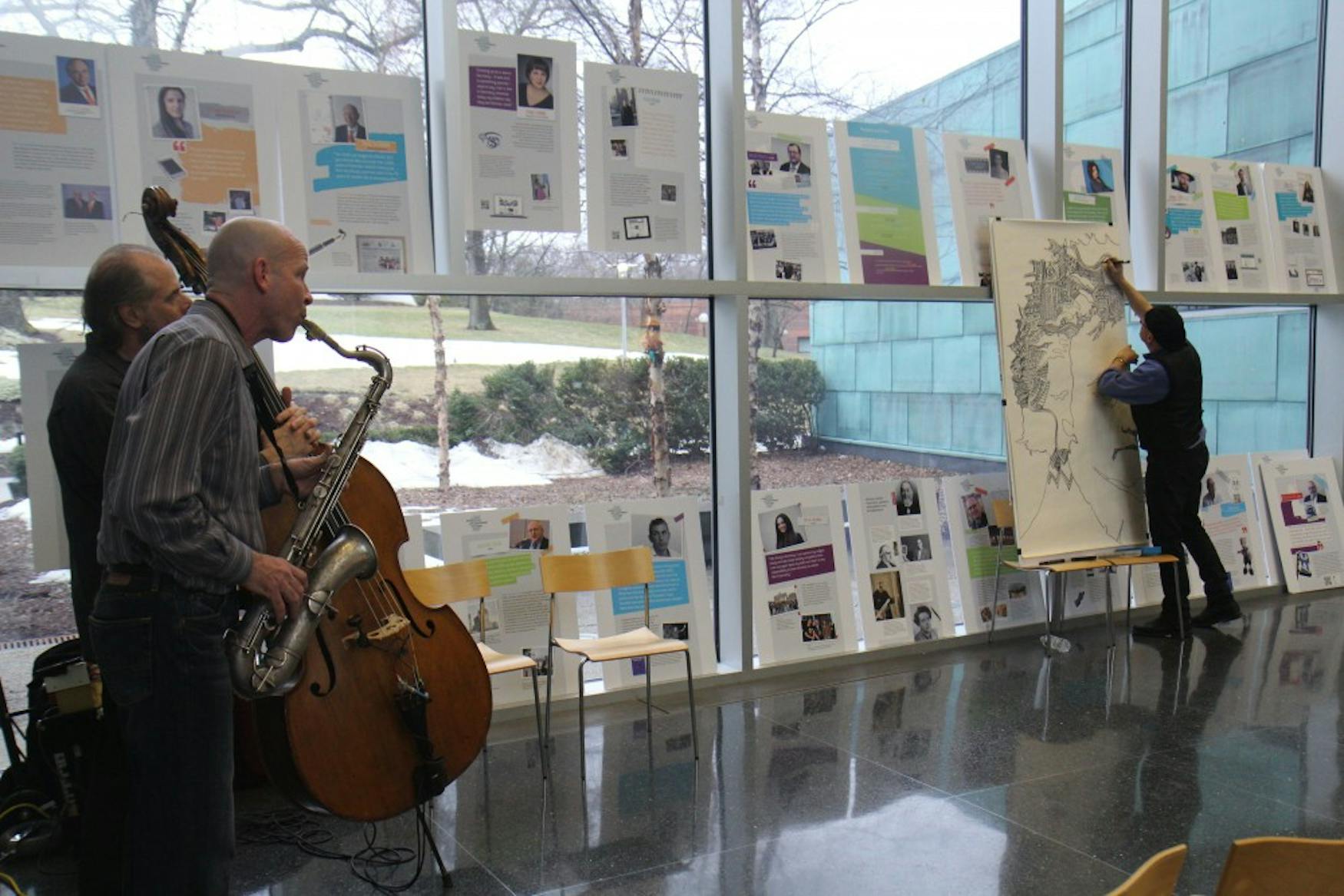Improvised music and art influence one another during Sound Line in SCC Atrium
Visual artist and musician Lennie Peterson says that he sees shapes when he listens to music. That is how he created a large-scale drawing of Beethoven this weekend in the Shapiro Campus Center Atrium, accompanied by Prof. Tom Hall (MUS) on the saxophone and Marty Ballou on the bass.
Peterson works professionally to makes these improvised drawings of famous musical figures. Ten are on view for their second year at the Boston Convention and Exhibition Center. For the drawings, Peterson always has in mind a specific musical figure who he will draw, and he starts his drawings by making a caricature outline. The improvising comes in when he starts to fill in the features of the face—the hair, eyes and mouth—with intricate patterns. Usually Peterson draws with pen, ink and oils but because he only had an hour, he used a magic marker for the portrait he created on Friday.
Creating these drawings is not Peterson’s only talent. He also created a comic strip called “Big Picture” that is now syndicated. He teaches, plays the trombone and has illustrated twelve children’s books. In fact, he drew illustrations for Hall’s book Free Improvisation: A Practical Guide that came out in 2010—which is how they know each other.
On Friday, in the true spirit of the Brandeis Improv Festival, there were two forms of improvisation taking place during the performance. Hall and Ballou were also improvising on the saxophone and bass. The trio blended with and fed off each other, creating two pieces of art at once.
When Hall and Ballou started playing, Peterson began by drawing a jagged outline on the border of the canvas. The figure was not recognizable until, in a dramatic movement, Peterson turned it on its head to reveal that the figure was Beethoven. The jagged lines had been the composer’s wild hair.
During the next piece, Peterson started filling in Beethoven’s hair with small patterns. Hall and Ballou’s improvising was very impressive. It was soothing and delicate, with light pizzicato from the bass and short, quiet staccatos from the saxophone. At times, Hall and Ballou would speed up and arrive at a mezzo forte or forte. They listened to each other closely and followed one another’s lead. “There’s really not that much thinking. It’s mostly just reacting—being involved, being in the moment with it,” said Hall.
Peterson followed along with the duo accordingly, speeding up and slowing down his drawing as the music changed. When Peterson stopped to take questions from the audience between Hall and Ballou’s improvised pieces, he was asked how he takes inspiration from the music. Peterson responded by first saying that he sees the music as shapes. He elaborated and said that the experience of drawing is also auditory for him—he can hear the pen hit the paper, punctuating the lines of music.
The drawing came out beautifully. Beethoven’s hair and facial features were covered in what seemed like possibly hundreds of different patterns. For comparison, Peterson had brought to the SCC a print of one of his drawings of Miles Davis—a piece for which he had had much more time. There was a distinct difference in the patterns between his Beethoven and his Davis.
The Davis was obviously more complex, but the types of details were also distinctly different with straighter, more ridged designs and checkerboard-like patters. The Beethoven, by contrast, was filled with swirls, spirals and squiggly lines that felt much more whimsical.
For Hall, the improvisation was a give and take—a collaboration of improvisation. “A lot of times I would [metaphorically] draw with his pen. But other times, when I wasn’t thinking about doing that, I would notice him starting to draw with me,” he said.



Please note All comments are eligible for publication in The Justice.